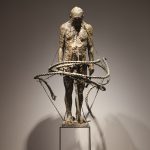
Laurence Edwards’s work has found its way into stately homes, public parks and domestic spaces. The versatility of environment that his work has thrived in showcases its ability to own the space around it, no matter how vast or small, domestic or wild. The difference between a thirteenth century tithe barn in Wiltshire and a Mayfair gallery might be boundless but the striking and enigmatic figures of Laurence Edwards populate both spaces with an atmosphere of mysterious omniscience.
The variability, however, between the individual pieces is exemplified by their curated groupings and placings. The collection of works in Wiltshire for example demand more from their space. Their volumous and shadowy stature possess their own kind of gravity while the pieces in London are preoccupied by more delicate forces; reflection, balance and line.
Wiltshire – Volume
Perhaps the first impression one might get from walking into the Barn and finding yourself amongst these towering characters is the effect of their scale. Not only scale in relation to the building or even to each other but to the viewer. One is confronted by the uneasy feeling of being looked down on from a height or the humbling experience of being eye to eye with a bust larger and taller than oneself. The lofty ceilinged space gives a sense of cathedral-esk verticality that lends a biblical tone to the weighty subjects.
London – Line
The preoccupations inherent in the pieces in Cork St are less to do with volume and more to do with tensions and forces such as that of rope, ties and supports. They elicit notions of the push and pull of encasement and a desire to break free, or the heaviness of the burden many of them carry. Often they suggest some conflict with visible outer forces and often invisible inner forces pertaining to the male psyche. Whatever their struggle these pieces are created with a lighter hand, they are the drawn line solidified in bronze.